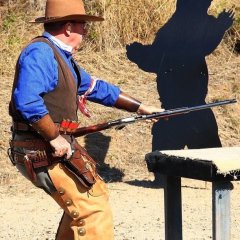-
Posts
7,472 -
Joined
-
Last visited
About Griff
- Birthday 08/04/1950
Previous Fields
-
SASS #
93
-
SASS Affiliated Club
Lone Star Frontier Shooting Club
Contact Methods
-
Website URL
http://
-
ICQ
60802859
-
Yahoo
sass93@yahoo.com
Profile Information
-
Gender
Male
-
Location
McLendon-Chisolm, TX
-
Interests
Cowboy Mounted Shooting, Hunting and Cowboy Action Shooting
Recent Profile Visitors
Griff's Achievements

SASS Wire Vet (1/1)
4.1k
Reputation
-

introduction: Advice Wanted for Getting Started in Cowboy Action Shooting
Griff replied to MaverickRV7's topic in SASS Wire
And maybe not so thoughtful... Shotgun poppers are particularly bad, as when hit, it is not with a single projectile, but rather a column of shot, so that the target is not at the same angle when hit with the tailing edge of the shot column as when hit with the first pellets. The target that might have rested at 5-10º from vertical, becomes vertical or slightly past vertical when trailing shot encounters the target face... this and due to the light weight of individual pellets has a tendency to fly further in rebound from a non static target. Shot that's been reclaimed is also harder than virgin chilled shot. It's called work hardened, and might not be as round as new shot. While not at all uncommon, I've been splattered with shot far more often than either handgun or rifle projectiles... But hey... what leisure time activity isn't fraught with a little peril? I've hit water that's more like concrete when speed skiing, hit with a golf ball when golfing, not to mention nearly being decapitated by an inebriated member of the foursome, dislocated my knee when dirt biking... -
I fit under several categories... does that make me a multi-tasker?
-
Unlike the Wire, at a match the phrase, "an armed society is a polite society..." comes to mind. In the many years I've spent in this game, I'm only privy to two altercations... and proving the lie to all the above, I was involved in both. Witnesses to either should feel free to comment.
-
I size, remove from station 1, check for proper length, trim if necessary, then replace in station one and proceed. (I have found a few to need it).
-
For cowboy in the handguns, I run a 160 grain RFN from Badman and in the rifle a 200 grain. For Wild Bunch in the Marlin 1894 I did the WidderMajik conversion on, I run a 200 grain from any of the makers that are using a Magma mold, or if I feel like casting my own, from a 6 cavity Lee 200 RFN mold.
-
While not terribly descriptive, most 45Auto/AR/Gap reloading die sets come with a taper crimp/seating die. The only one making a dedicated ROLL CRIMP die for the 45Auto/AR/GAP is RCBS, as a stand alone product... no available in any set. part nbr: 18942. Neither the Lee Factory Crimp Die nor the Redding Profile Crimp Die are described very well in the literature I could find. But, as seen here, the Lee FCD for the 45 Auto is still a taper crimp die. Whereas the RCBS Roll Crimp Die imparts a much more dramatic crimp to the C45S:
-
I apparently misremembered... musta been thinking of the .40-65!
-
Same reason the '73 action doesn't like wadcutter or semi-wadctter ammo, as the square face of the chamber mouth meeting a sharp corner on the ammo will more likely need "jiggling" to have a square peg go in a round hole. Can be "fixed" by rounding over the chamber mouth very slightly, or simply using using a roll crimp on RFN or TC bullets.
-
Either Lyman's 4th Edition Cast Bullet or the 48th thru 51st Editions of their Reloading Handbooks.
-
I don't know about them "ferin" guns, but... my Colt auto loading pistols say, "45 Auto" on the barrel as viewed thru the ejection port. Even my brass sez "45 Auto"... Is yours different? {Doin' my bit to get 'er to 3 pages)!
-

introduction: Advice Wanted for Getting Started in Cowboy Action Shooting
Griff replied to MaverickRV7's topic in SASS Wire
Don't just go out and observe... no need to be pushy, but introduce yourself to the folks hosting the match, and ask questions. Ask about their gear and what drove their decisions for that particular stuff. Offer to help out, one of the biggest chores at most clubs is getting folks to stick around put away steel at the end of the match, clearly when the day is near its hottest and everyone's wore smooth out! Your stock is magnified by this simple gesture. -
I question the wisdom of pinning it on SASS' website as several loadings exceed 1,000 fps. It's value as a real guide to loading for cowboy action is questionable IMO.
-

Would you be willing to share some reloading data…I won’t blow myself up.
Griff replied to MaverickRV7's topic in SASS Wire
Please note that many loads listed in this "cowboy" load manual are over the 1,000 fps limit for pistols. Next, a word of advice, getting as close as you can to a 60PF is not necessarily conducive to fast times. If it's difficult to distinguish between your shot and a squib, you're flirting with disaster. "Staying on target" isn't necessary either, smooth transitions from one target to the next is. What I did was pick a velocity that I felt would give me adequate recoil to give positive feedback without spoiling my movement between targets, (mine happens to be about 725 fps for pistol ammo), then found an on-line reloading manual (Hodgdon's is a good source) that listed powders I had, and for those listings that didn't have a 700-725 minimum, found an on-line load reduction calculator and proceeded to enter my info. Even more than reducing powder charge, reducing the weight of the payload will affect felt recoil more than dropping powder charges with heavier bullets.



_02-781336.thumb.jpg.f4a75bbb74124e28370c8d589db5938f.jpg)




